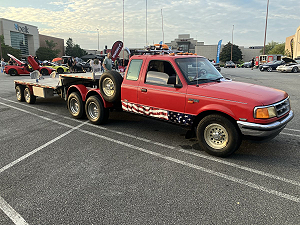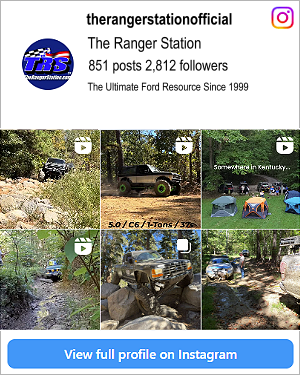PanamaExpat
Well-Known Member
- Joined
- May 28, 2011
- Messages
- 1,076
- Reaction score
- 13
- Location
- Panama City, Rep. of Panama
- Vehicle Year
- 1994
- Make / Model
- Mazda
- Engine Size
- 4 liter
- Transmission
- Manual
NOTE: Please read all the way through BEFORE setting up a system like this for yourself. Done properly it is safe and not environmentally hazardous. There are however things that you need to be aware of when de-rusting and or cleaning parts with this system. I claim no responsibility for damages or injuries if you should decide to use this.
While in the process of restoring/modifying my 1994 B4000 I have concluded that if anything can rust on an 18 year old truck it will. Never being one to shy away from a task I must admit I am getting increasingly tired of getting face and eyes (while running wire brush on angle grinder I wear a full face welding helmet and my full length welding gloves) full of crud and flying steel wire shards impaling themselves in my body as they fly off the brush attachment on the angle grinder. Now it seems that every part I have removed from the undercarriage needs some attention and I don’t have a sand blaster built yet though it is in the plans I need a simple solution to rusty dirty painted parts that won’t wear me out. So in my quest I turned to science and some good old hillbilly engineering to solve this problem.
Remember back somewhere about the eighth grade when your teacher set up a pair of inverted test tubes in a beaker of water and placed an electrode beneath each tube then connected it to a battery or DC power supply? If you recall a reaction took place and the electrodes started bubbling filling the test tubes with gas. One filled with twice the volume of the other as the electricity was breaking the molecular bond between the hydrogen and oxygen atoms in the water in a process called electrolysis. Now a Mr. Wizard fact not pertinent to the procedure: One tube filled roughly double the volume of gas that filled the other as H2O is on atom of hydrogen and two of oxygen the oxygen side naturally releases double the amount of gas. Then of course you get the fun of removing the hydrogen filled test tube flipping it right side up while simultaneously igniting the escaping gas and you recreate water. So much for science class now let’s get back to our metal cleaning procedure.
Now we aren’t too concerned about the gasses generated by this process what we are interested in is the reaction of the metals being used as the anode (positive) and cathode (negative) to create the electrolysis in the first place. So in order to perform electrolysis we need a few basic items. You have to have an electrolyte solution, a tank to hold it in, some sacrificial metal for the anode, and a sufficient power supply. Not one to start really small I opted for a cracked but repaired fiberglass bath tub that I had stored in the attic of the garage as I plan to clean larger parts like radius arms and D35 TTB axel beams.
 The electrolyte which consists of water and sodium carbonate (the stuff you use to adjust PH of swimming pools) or as in my case sodium bicarbonate (baking soda) If you are not in a hurry to experiment as I was you can make sodium bicarbonate into sodium carbonate by spreading it out on a cookie sheet and baking it at 325 f for an hour and ten minutes.
The electrolyte which consists of water and sodium carbonate (the stuff you use to adjust PH of swimming pools) or as in my case sodium bicarbonate (baking soda) If you are not in a hurry to experiment as I was you can make sodium bicarbonate into sodium carbonate by spreading it out on a cookie sheet and baking it at 325 f for an hour and ten minutes.
 Sacrificial metal in my case an old piece of expanded metal salvaged from the scrap pile out back.
Sacrificial metal in my case an old piece of expanded metal salvaged from the scrap pile out back.
 You can use many things for this but I recommend steel or stainless steel. Note on using stainless. I had a warning here about the creation of the compound hexavalent chromium but DRanger024 posted further down that this process will not create hexavalent chromium and with the proofs he has stated I have edited the warnings on this subject. Now I will only say that there are reports that there is a possibility of stainless creating hexavalent chromium so please use stainless at your own risk. Ingesting or breathing chromium is bad for your health and should be avoided at all costs. The waste component from steel is harmless and diluted you can even discharge it onto your lawn. I will be upgrading my tank to utilizing stainless for the sacrificial anode as I am going through the expanded metal pieces at a fairly rapid pace. Hopefully using stainless will also keep the electrolyte cleaner for a longer period of time (I will update this as soon as I have experience using stainless.)
You can use many things for this but I recommend steel or stainless steel. Note on using stainless. I had a warning here about the creation of the compound hexavalent chromium but DRanger024 posted further down that this process will not create hexavalent chromium and with the proofs he has stated I have edited the warnings on this subject. Now I will only say that there are reports that there is a possibility of stainless creating hexavalent chromium so please use stainless at your own risk. Ingesting or breathing chromium is bad for your health and should be avoided at all costs. The waste component from steel is harmless and diluted you can even discharge it onto your lawn. I will be upgrading my tank to utilizing stainless for the sacrificial anode as I am going through the expanded metal pieces at a fairly rapid pace. Hopefully using stainless will also keep the electrolyte cleaner for a longer period of time (I will update this as soon as I have experience using stainless.)
Finally you need a steady DC power source. Most folks use a battery charger but mine had a meltdown similar to Chernobyl a couple months back and is basically scrap. So I will rely on the trusty Hobart.

You don’t want a boat load of amperage and I have done all my electrolyzing at 35 amps DC. Please REMEMBER to only perform this with DC. AC will eat the cathode (the piece you are working on) as well as the anode. Also do not hook the positive (anode) to your work at any time as it will become the sacrificial piece at that point. ONLY CONNECT THE NEGATIVE TO THE PIECE YOU ARE CLEANING. I will not be responsible for damages to your parts if you hook this up backwards. Another important thing to remember when working around water and electricity is TURN OFF THE POWER SOURCE ANYTIME YOU PLAN TO STICK YOUR HAND IN THE WATER or move any of the parts you are cleaning. You wouldn't want the pieces contacting and creating a short circuit in your tank.
Now set your tank up as shown in the first photo. Fill it up to around 3” below the top with water and add 2 cups of sodium carbonate to the water (mix well). I discovered shortly after setting this up the next morning as a matter of fact that you don’t want the gator clip below the surface as it gets sacrificed VERY fast. I’ll post some photos of the improved setup a little further down. Another thing you can add to the water is about a cup of laundry detergent. This cuts grease and your parts come out almost paint ready.
Next we will demonstrate on our first victim. I chose this brake drum as our volunteer. As you can see it looks really rusty.

No need to do anything special to it. If your part is covered in mud you may want to wash it off as you don’t need to add even more crud to your tank than it is going to generate on its own. I use nylon twine to suspend the parts in the tank. MAKE CERTAIN THAT THE PART DOES NOT CONTACT THE SACRIFICIAL STEEL OR YOU WILL HAVE UNDERWATER FIREWORKS.

Now hook up your power source. Pay attention to what you are doing. Remember this is water and electricity we are playing with. You may want to secure the area from children and curious pets as well. Another word of caution: Make certain you have adequate ventilation the hydrogen gas produced by this process could have explosive results if concentrated in a small area and ignited. Think Hindenburg “Oh the humanity.”

Once you have verified that everything is ready. TURN ON THE JUICE and if you have followed instructions you should see the water start to fizz like club soda around the part.
If all is going as planned this is what should happen when you turn on the power.

This is what things look like about an hour into the process.


As you can see lots of the oxidation is already gone. On parts that are this rusty I recommend an overnight bath in the tank. Then in the morning all you need to do is give them a bath with a hose and a Scotch Brite and you will have CLEAN bare metal. Note: When handling parts I have found you need a good pair of rubber gloves or you will have a Snookie style orange tan where your bare skin enters the water. The following image is fresh out of the tank after 12 hours and before rinsing. The black will come right off with a scrub brush or Scotch Brite.

A note on Scotch Brite: The ones you use for dishes are kind of useless around the shop. I go to the floor care area of our local builder supply and buy the red 24" floor scrubbing pads and cut them into pieces as needed. They are way more durable and coarse than your standard pad and a whole lot cheaper.
Once you have rinsed your parts be prepared to dry them and oil or paint them IMMEDIATELY as you can actually watch them rust as they dry.
I will add some photos of the setup as it is now and post any tips and tricks that I learn as I go along. You will notice that the water in the tank will get warm to hot over time (this actually is beneficial to removal of grease and slime) so use caution when sticking your hands in after it has been in operation for a while. The soda solution is only there to benefit the conductivity of the water. It does not decay or play any role in the actual cleaning process. The solution will become quite dirty but this does not affect the action of the water. You can use the same solution for up to a year before you need to change it. You will lose water due to the electrolytic process and evaporation. Simply top up the tank as needed.
This process is NOT recommended for aluminum. Aluminum parts cleaned will come out black.
So far I have done everything on my TTB. I do not recommend using on parts that have bearings or bearing races installed as the process can cause a molecular change to hardened metals. Also it is not a good idea to put small springs in the process. They will get brittle and break. However suspension coils and leafs should be OK as long as you pull them out when the rust is removed. This process will lift paint, powder coating, varnish, and just about any other finish from steel. It will remove rust but not effect chrome. That is if the plating job was a good one.
Let me know if you have any questions and I will answer them as best as I can. As with anything use this at your own risk and your results may vary.
While in the process of restoring/modifying my 1994 B4000 I have concluded that if anything can rust on an 18 year old truck it will. Never being one to shy away from a task I must admit I am getting increasingly tired of getting face and eyes (while running wire brush on angle grinder I wear a full face welding helmet and my full length welding gloves) full of crud and flying steel wire shards impaling themselves in my body as they fly off the brush attachment on the angle grinder. Now it seems that every part I have removed from the undercarriage needs some attention and I don’t have a sand blaster built yet though it is in the plans I need a simple solution to rusty dirty painted parts that won’t wear me out. So in my quest I turned to science and some good old hillbilly engineering to solve this problem.
Remember back somewhere about the eighth grade when your teacher set up a pair of inverted test tubes in a beaker of water and placed an electrode beneath each tube then connected it to a battery or DC power supply? If you recall a reaction took place and the electrodes started bubbling filling the test tubes with gas. One filled with twice the volume of the other as the electricity was breaking the molecular bond between the hydrogen and oxygen atoms in the water in a process called electrolysis. Now a Mr. Wizard fact not pertinent to the procedure: One tube filled roughly double the volume of gas that filled the other as H2O is on atom of hydrogen and two of oxygen the oxygen side naturally releases double the amount of gas. Then of course you get the fun of removing the hydrogen filled test tube flipping it right side up while simultaneously igniting the escaping gas and you recreate water. So much for science class now let’s get back to our metal cleaning procedure.
Now we aren’t too concerned about the gasses generated by this process what we are interested in is the reaction of the metals being used as the anode (positive) and cathode (negative) to create the electrolysis in the first place. So in order to perform electrolysis we need a few basic items. You have to have an electrolyte solution, a tank to hold it in, some sacrificial metal for the anode, and a sufficient power supply. Not one to start really small I opted for a cracked but repaired fiberglass bath tub that I had stored in the attic of the garage as I plan to clean larger parts like radius arms and D35 TTB axel beams.



Finally you need a steady DC power source. Most folks use a battery charger but mine had a meltdown similar to Chernobyl a couple months back and is basically scrap. So I will rely on the trusty Hobart.

You don’t want a boat load of amperage and I have done all my electrolyzing at 35 amps DC. Please REMEMBER to only perform this with DC. AC will eat the cathode (the piece you are working on) as well as the anode. Also do not hook the positive (anode) to your work at any time as it will become the sacrificial piece at that point. ONLY CONNECT THE NEGATIVE TO THE PIECE YOU ARE CLEANING. I will not be responsible for damages to your parts if you hook this up backwards. Another important thing to remember when working around water and electricity is TURN OFF THE POWER SOURCE ANYTIME YOU PLAN TO STICK YOUR HAND IN THE WATER or move any of the parts you are cleaning. You wouldn't want the pieces contacting and creating a short circuit in your tank.
Now set your tank up as shown in the first photo. Fill it up to around 3” below the top with water and add 2 cups of sodium carbonate to the water (mix well). I discovered shortly after setting this up the next morning as a matter of fact that you don’t want the gator clip below the surface as it gets sacrificed VERY fast. I’ll post some photos of the improved setup a little further down. Another thing you can add to the water is about a cup of laundry detergent. This cuts grease and your parts come out almost paint ready.
Next we will demonstrate on our first victim. I chose this brake drum as our volunteer. As you can see it looks really rusty.

No need to do anything special to it. If your part is covered in mud you may want to wash it off as you don’t need to add even more crud to your tank than it is going to generate on its own. I use nylon twine to suspend the parts in the tank. MAKE CERTAIN THAT THE PART DOES NOT CONTACT THE SACRIFICIAL STEEL OR YOU WILL HAVE UNDERWATER FIREWORKS.

Now hook up your power source. Pay attention to what you are doing. Remember this is water and electricity we are playing with. You may want to secure the area from children and curious pets as well. Another word of caution: Make certain you have adequate ventilation the hydrogen gas produced by this process could have explosive results if concentrated in a small area and ignited. Think Hindenburg “Oh the humanity.”

Once you have verified that everything is ready. TURN ON THE JUICE and if you have followed instructions you should see the water start to fizz like club soda around the part.
If all is going as planned this is what should happen when you turn on the power.

This is what things look like about an hour into the process.


As you can see lots of the oxidation is already gone. On parts that are this rusty I recommend an overnight bath in the tank. Then in the morning all you need to do is give them a bath with a hose and a Scotch Brite and you will have CLEAN bare metal. Note: When handling parts I have found you need a good pair of rubber gloves or you will have a Snookie style orange tan where your bare skin enters the water. The following image is fresh out of the tank after 12 hours and before rinsing. The black will come right off with a scrub brush or Scotch Brite.

A note on Scotch Brite: The ones you use for dishes are kind of useless around the shop. I go to the floor care area of our local builder supply and buy the red 24" floor scrubbing pads and cut them into pieces as needed. They are way more durable and coarse than your standard pad and a whole lot cheaper.
Once you have rinsed your parts be prepared to dry them and oil or paint them IMMEDIATELY as you can actually watch them rust as they dry.
I will add some photos of the setup as it is now and post any tips and tricks that I learn as I go along. You will notice that the water in the tank will get warm to hot over time (this actually is beneficial to removal of grease and slime) so use caution when sticking your hands in after it has been in operation for a while. The soda solution is only there to benefit the conductivity of the water. It does not decay or play any role in the actual cleaning process. The solution will become quite dirty but this does not affect the action of the water. You can use the same solution for up to a year before you need to change it. You will lose water due to the electrolytic process and evaporation. Simply top up the tank as needed.
This process is NOT recommended for aluminum. Aluminum parts cleaned will come out black.
So far I have done everything on my TTB. I do not recommend using on parts that have bearings or bearing races installed as the process can cause a molecular change to hardened metals. Also it is not a good idea to put small springs in the process. They will get brittle and break. However suspension coils and leafs should be OK as long as you pull them out when the rust is removed. This process will lift paint, powder coating, varnish, and just about any other finish from steel. It will remove rust but not effect chrome. That is if the plating job was a good one.
Let me know if you have any questions and I will answer them as best as I can. As with anything use this at your own risk and your results may vary.
Last edited:














